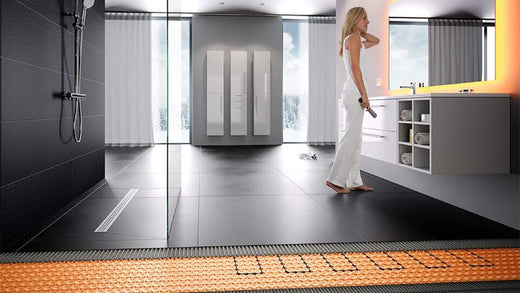Imagine the comfort of stepping onto a heated floor in your hallway, kitchen, or bathroom on a chilly day. Achieving this luxury requires careful planning and adherence to specific installation protocols. The entire process involves preparing the installation surface, laying heating wires, having an electrician validate connections, applying adhesive cement, and finally, installing the surface covering. Additionally, prior to commencing installation, it’s essential to select a floor covering compatible with underfloor heating.
NAVIGATION YOUR OPTIONS : CHOOSING THE RIGHT FLOOR COVERINGS
The first step is selecting the appropriate flooring, as not all materials are suitable for underfloor heating. It’s vital to consider materials that work well with heat..
HIGH TEMPERATURE COMPATIBLE MATERIALS
Ceramic and porcelain tiles are the top choices due to their exceptional thermal conductivity, allowing them to transmit and retain heat effectively. This choice maximizes comfort while minimizing energy consumption. Moreover, in the event of a system failure, only the affected tiles need replacement, avoiding the need for complete floor removal.

Ayers grey porcelain (EXCLUSIVE TO CERAMIQUE L'ENTREPÔT)
Vinyl is another cost-effective option that provides the benefits of a heated floor. Engineered wood can also be used, but caution is advised, as some varieties may not be compatible. It is wise to consult an expert if you have any uncertainties.
TYPES OF COATINGS INCOMPATIBLE WITH HEAT
Hardwood is generally unsuitable for underfloor heating due to its sensitivity to temperature and humidity fluctuations, which can cause it to warp or crack. Cork is also inadvisable, as its insulating properties can impede heat transfer, reducing the system's effectiveness.

ESSENTIAL CONSIDERATIONS FOR INSTALLING UNDERFLOOR HEATING
Installing a heated floor cannot be improvised. Even if it is not a high-flying renovation project, it requires the intervention of a master electrician (therefore a member of the CMEQ ) and, depending on your DIY skills, a professional floor installer.
PREPARING THE INSTALLATION SURFACE
Are you more of a DIYer? Then you'll be happy to learn that you can get involved in this step! In fact, it involves ensuring that your entire surface meets current construction standards. In most cases, we're talking about installing a decoupling membrane. In particular, it provides a certain flexibility to the floor once all the work is completed. For example, it will prevent cracks in your floor.

INSTALLATION OF HEATING WIRES
So here we are at the stage of installing the heating wires. Although this is not a particularly difficult step, it is nonetheless delicate. Indeed, everything must be done carefully and nothing must be overlooked, because cement is poured on the system after its installation (next step). We also mention that this part of the project requires the services of a master electrician. He will be able to ensure that all the work has been done according to the rules.

Source: Schluter.ca
APPLYING ADHESIVE CEMENT
Next comes the installation of heating wires. While this step is not particularly difficult, it demands precision. Care must be taken, as cement will be poured over the system afterward. This task should also involve a master electrician to ensure all work complies with regulations.
INSTALLATION THE SURFACE COVERING
Now we are at the stage of installing your surface covering (or your floor covering). As mentioned above, double-check the thermal compatibility of the type of covering selected. Ask an advisor before purchasing and, if necessary, ask a qualified professional for help in installing the surface covering.

Source: Schluter.ca
CONNECTING THE THERMOSTAT AND FINAL CONNECTIONS
Connecting the thermostat and the heating system to your electronic panel are, in a way, the final touch to your project. However, this must be done by a master electrician in order to comply with the building code.

READY TO INVEST IN HEATED FLOOR ?
Considering the purchase of a heated floor? It’s a fantastic decision that will enhance your comfort and well-being. However, like any substantial home renovation, it requires careful planning and execution, spanning from floor covering selection to the installation of the heating system.
If you have questions or need materials to kickstart your project, we offer a wide selection of ceramics and floor coverings, along with everything needed for underfloor heating installation. Contact us today to get started.
Did you like this text ? You will probably also like :
- Flooring Trends to Watch in 2024
- Fireplace Mantel : 7 Ideas to Enhance Your Home
- Ceramic Floor Maintenance Guide
- The ideal Maintenance for Laminate and Vinyl Flooring
- Bathroom Décor : Inspiring Desing Featuring Wood-Effect Ceramics
- 8 Innovative Idea for Laying Your Metro Ceramic Tiles
- Creating the Perfect Home Office : Top Floor Covering Options
- Can Exterior Tiles Replace Exterior Paving ?
- Calculating Surface Area for Floor Covering
- Flooring Trends to Watch in 2025

